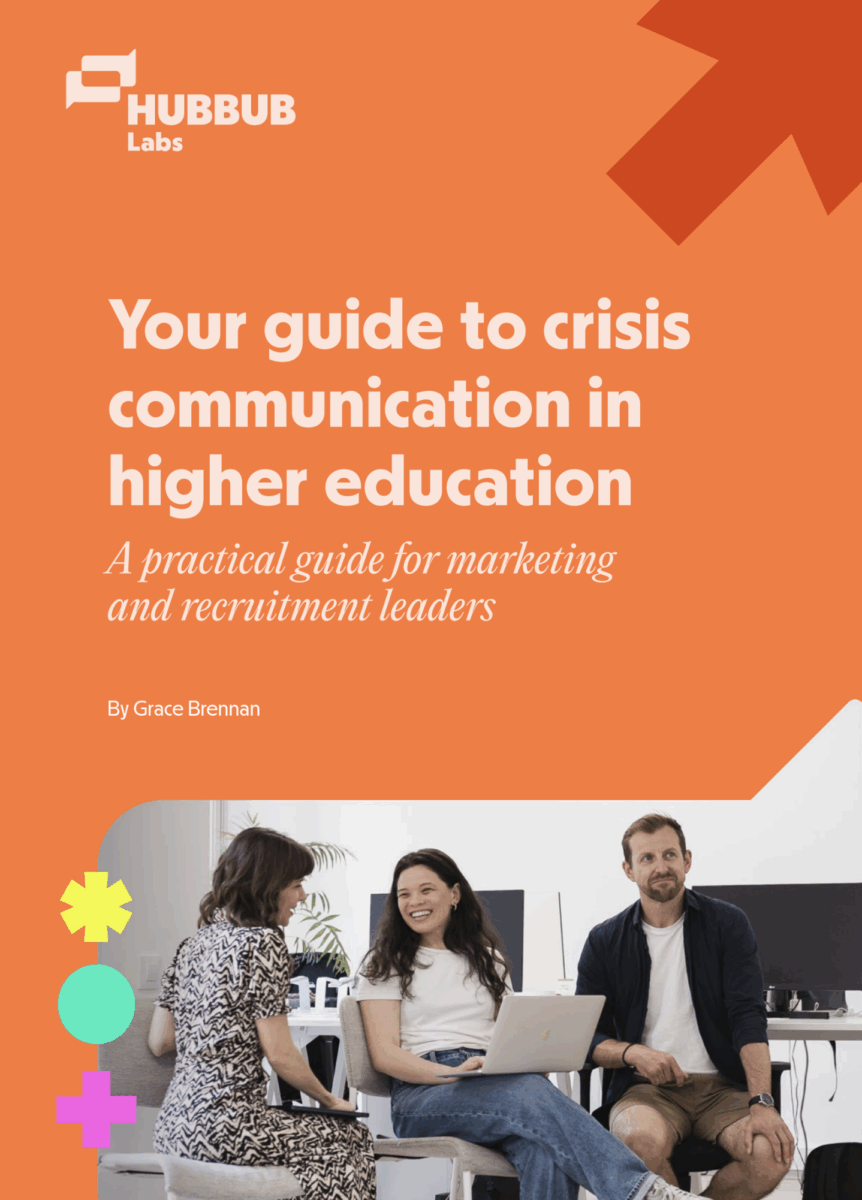Bringing clarity, consistency, and credibility to your story
Education is a crowded, competitive and often horribly undifferentiated industry. When almost every institution claims to “empower learners” or “transform futures”, who’s going to stand out? Only the few risk-takers who dare to be distinct.
So how does your institution or brand fare when people hear your brand or institution’s name? If the feedback in brand tracking surveys is more meh than wow, you need to work on your positioning and messaging. It’s the first step to getting noticed and coming to mind when it counts.
Get your guide to crisis comms
Won’t get to the end? Here’s a quick TL;DR
In education, you’re serving multiple stakeholders – and that’s complicated. A messaging framework makes it simple, ensuring everyone is telling the same, authentic story and in a way that makes sense to your different audiences. It also desilos your teams and aligns marketing, admissions, and academics around a shared narrative.
At Hubbub Labs, we help education brands build clear, evidence-based messaging frameworks that capture your essence as a brand. Let’s talk about your story.
First, what is a messaging framework?
A messaging framework is a single source of truth, allowing education brands to communicate their value consistently and persuasively across all key moments in the buyer’s journey. Your framework helps breathe life and colour into your strategic positioning, turning it into words and stories that people can actually use.
Inside a messaging framework, you’ll find:
Messaging Pillars: You might have five or so key themes that define your brand’s strengths and differences. For instance, community, technology, rural connection, curiosity and trail-blazing.
Value Propositions: what you offer and how you’re distinct matter differently to each target segment of your audience. We help you map each value proposition and emotional benefit to your various partner, buyer, and student personas – in order of priority.
Proof points: these are your undeniables – or the tangible pieces of evidence that back up each pillar and each value proposition. These proof points might include data, testimonials, rankings, case studies, etc.
Objection handling: these are ready-made responses to deal-breakers like cost, time, relevance, or outcomes and are designed for marketing, admissions and sales teams. Objection-handling prompts and pitches help guide you past tricky forks in the road, especially when it comes to scripting sales calls and conversations.
Audience stories: our evidence-based, adapted short and long versions of your story keep your team focused on your enrolment or sign-up goals. We adapt your story for students, parents, agents, teachers, employers, or partners – and ensure your messages resonate more strongly.
Pitches: these are the marriage of your positioning and messaging, where the value propositions you’ve identified for each target segment are placed in a hierarchy for each audience segment. We voice how you meet the goals, needs and challenges of your audiences – and help make you an irresistible proposition.
Taglines: Just do it. Think different. I’m Lovin’ it. Having a single powerful tagline (or several that support courses and offers) helps create brand stickiness, which is an excellent way to worm your way into the brains of your students or clients.
The role of authenticity in effective messaging
Inauthentic messaging always stands out for the wrong reasons. For example, when a fossil fuel enterprise starts talking about its green energy investments, many people feel a strong disconnect. No matter how much money they’ve invested in comms or marketing campaigns, the message doesn’t ring true. Why? Because sustainability is not an evident part of the brand’s actions, history or story. They’re sucking up oil and gas from the ground and asking us to burn it, for starters.
Strong brand messaging, in contrast, starts with authenticity.
Before defining what you say or how you say it, you need to be clear on;
- what you do in the world (first)
- who you are (second)
- why you exist (third).
Which leads us on to your mission statement. It isn’t just bit of corporate fluff – used properly, it can be the foundation of your organisation’s operations, decisions, and communications. When every message flows naturally from that purpose, your audience will notice the alignment between what you believe, what you do, and what you say.
Anyone within your organisation (from a professor to a recruiter to a student ambassador) can represent your brand authentically if they know what they’re representing and why. That shared understanding creates a genuine, confident voice that connects.
If your brand’s purpose and story feel disconnected, Hubbub Labs can help you articulate a clear mission and translate it into authentic, actionable messaging. Get in touch.
How strong messaging guidelines support global teams and partners
Whether you’re a university recruiting internationally, a transnational education offer (TNE), an EdTech scaling across languages, or a school group expanding domestically, consistency with flexibility in messaging is key.
Your messaging framework bridges the gap between global strategy and local campaign execution and delivery. It ensures that your brand promise stays intact, while local teams adapt it for tone, culture, context and even language. It’s a foundation that doesn’t hamstring creativity or cultural relevance.
In short:
- Global HQ defines the “what” and “why.” (Brand promise, pillars, proof, and key narratives.)
- Local markets define the “how.” (Examples, channels, translations, imagery, and tone.)
For example, a global EdTech brand might have a core message — “Empowering learners to achieve more.” In India, it translates to access and affordability; in Germany, it emphasises quality and recognition. The story flexes, but the foundation stays solid.
Supporting external agencies
When working with external creative or media partners, a clear messaging guide becomes a shortcut to alignment. Agencies instantly understand:
- What the brand stands for
- Which proof points to use
- What tone fits (and what doesn’t)
- How to differentiate from competitors
Instead of re-briefing from zero each time, your messaging framework becomes a central resource and the North Star for every campaign and pitch deck. This saves time, reduces revisions, and ensures creative consistency across agencies and regions.
Onboarding new team members
For new marketers, admissions officers, or regional reps, messaging guidelines act as a fast-track to brand fluency. It helps them to quickly grasp:
- the brand’s promise and proof points
- key audience narratives
- the tone and vocabulary that reflect the institution’s personality
The broader benefits of a strong messaging framework
A messaging framework delivers more than consistency, it’s a strategic tool that fosters:
1. Strategic alignment
Keeps marketing, admissions, and leadership united around a shared story. No more competing narratives between departments because everyone pulls in the same direction.
2. Faster decision-making
Eliminates subjective debates over copy or creative direction. Every campaign can be tested against one question: does this reinforce our core message?
3. Storytelling consistency
Creates a recognisable brand voice across digital, print, and face-to-face communications. Repetition with relevance builds trust and recall.
4. Efficient content production
Teams and agencies can move faster with ready-to-use pillars and proof points. No more reinventing the wheel for every new campaign.
5. Better campaign integration
Connects your brand-level messaging with tactical campaigns, ensuring every initiative reinforces the overarching story.
6. Stronger brand culture
Helps staff and student ambassadors internalise the story and creates authentic, on-brand experiences both online and on campus.
7. Future-proofing for AI and automation
As education brands often use AI for content and chatbots, frameworks ensure tone, message, and structure remain on-brand.
8. Clearer measurement
Consistent pillars make it easier to analyse campaign data, survey responses, and audience sentiment against specific brand themes.
9. True distinction
Pushes brands to define what’s genuinely unique and evidence-backed. You’ll be cutting through a market saturated with “innovation” and “excellence.”
What’s next?
Beyond consistency, a strong messaging framework drives alignment, speed, and differentiation. It’s not just a communications tool, it’s a data-driven strategic basis for all your education marketing campaigns.
If you’re ready to align your messaging and tell your brand story, Hubbub Labs can help you build a framework that works in the real world. Get in touch below.

Get your guide to crisis comms
This guide helps you:
- Communicate with clarity under pressure
- Minimise long-term impact and get back to normal faster
- Protect your reputation and your people






